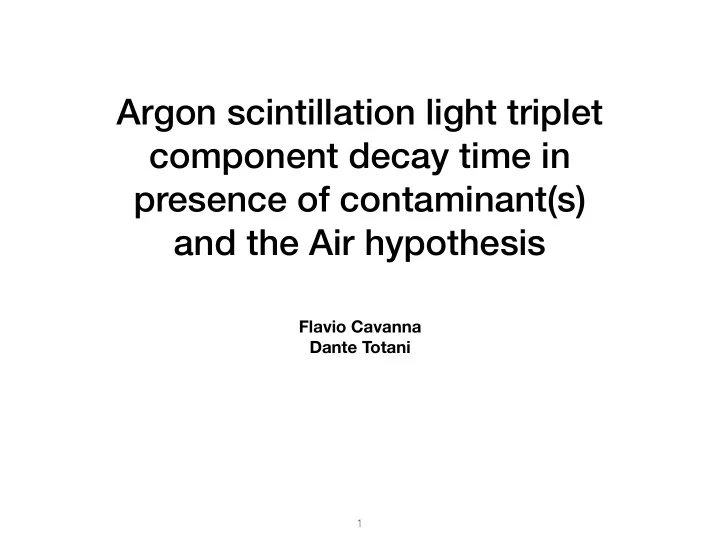

Argon scintillation light triplet component decay time in presence of contaminant(s) and the Air hypothesis Flavio Cavanna Dante Totani � 1
Average waveform normalized from channel 270 Red= run 9004 Blue= run 8562 � 2
Single photon response: The single photon response comes from calibrations runs. A pulsed LED lightened the PD modules giving a signal which is totally dependent from the MPPS response to the single photon (or more photons “contemporary”) Since after pulses and cross talks, a single photon detected can give more than one avalanche. This means that a single photon detected can populate the peaks beyond the first. Through the Poisson statistic we can get the average response to a single photon detected λ = − ln ( N Tot ) N 0 Max amplitude [ADU] � 3
Single photon response normalized from channel 270 In these considerations we are assuming that the LED light pulse is a delta function. � 4
Comparing the Single photon response we can see how the scintillation light from ionizing events di ff ers from the single photons response All the di ff erences should be due to the LAr scintillation light structure in time � 5
The average waveforms are then deconvoluted for these single photon response and fitted with the function: f ( t ) = A + B ⋅ exp( − t / τ ) Run 8562 ch270 Tick [1=6.67 ns] � 6
Run 9004 ch270 Tick [1=6.67 ns] � 7
An average of the values obtained for each Arapuca channel gives the following values Run 9004 Run 8562 <Tau> Arapuca1 : 765 ns <Tau> Arapuca1 : 1263 ns <Tau> Arapuca2 : 762 ns <Tau> Arapuca2 : 1297 ns Arapuca 1 means Arapuca PD module in APA 3 (beam side) Arapuca 2 means Arapuca PD module in APA 6 (no-beam side) � 8
Run 8562 Run 9004 DAQch: 1 Tau t= 1281.68 ns DAQch: 1 Tau t= 874.876 ns DAQch: 2 Tau t= 1397.07 ns DAQch: 2 Tau t= 890.906 ns DAQch: 3 Tau t= 1309.93 ns DAQch: 3 Tau t= 882.734 ns DAQch: 4 Tau t= 1166.01 ns DAQch: 4 Tau t= 671.433 ns DAQch: 5 Tau t= 1149.52 ns DAQch: 5 Tau t= 748.434 ns DAQch: 6 Tau t= 1123.27 ns DAQch: 6 Tau t= 640.75 ns DAQch: 7 Tau t= 1165.98 ns DAQch: 7 Tau t= 651.294 ns DAQch: 8 Tau t= 1284.1 ns DAQch: 8 Tau t= 713.695 ns DAQch: 9 Tau t= 1346.99 ns DAQch: 9 Tau t= 767.622 ns DAQch: 10 Tau t= 1317.68 ns DAQch: 10 Tau t= 772.635 ns DAQch: 11 Tau t= 1298.19 ns DAQch: 11 Tau t= 799.018 ns DAQch: 12 Tau t= 1324.72 ns DAQch: 12 Tau t= 771.664 ns DAQch: 13 Tau t= 1238.85 ns DAQch: 13 Tau t= 727.221 ns DAQch: 14 Tau t= 1193.46 ns DAQch: 14 Tau t= 746.412 ns DAQch: 15 Tau t= 1285.95 ns DAQch: 15 Tau t= 738.458 ns DAQch: 16 Tau t= 1230.48 ns DAQch: 16 Tau t= 725.76 ns DAQch: 17 Tau t= 1363.56 ns DAQch: 17 Tau t= 848.436 ns DAQch: 18 Tau t= 1388.69 ns DAQch: 18 Tau t= 789.197 ns DAQch: 19 Tau t= 1419.86 ns DAQch: 19 Tau t= 835.554 ns DAQch: 20 Tau t= 1272.79 ns DAQch: 20 Tau t= 700.478 ns DAQch: 21 Tau t= 1315.56 ns DAQch: 21 Tau t= 792.706 ns DAQch: 22 Tau t= 1222.39 ns DAQch: 22 Tau t= 702.004 ns DAQch: 23 Tau t= 1302.91 ns DAQch: 23 Tau t= 788.414 ns DAQch: 24 Tau t= 1334.82 ns DAQch: 24 Tau t= 749.985 ns <Tau> Arapuca1 : 1263 ns <Tau> Arapuca1 : 765 ns <Tau> Arapuca2 : 1297 ns <Tau> Arapuca2 : 762 ns � 9
The scintillation of liquid argon T. Heindl, T. Dandl, M. Hofmann, R. Krucken, L. Oberauer, W. Potzel, J. Wieser , A. Ulrich 2010 EPL 91 62002 � τ T 0 = 1300 ± 60 ns � 10
Light Quenching Effects of Nitrogen contamination in liquid Argon Oxygen contamination in liquid Argon R Acciarri et al 2010 JINST 5 P06003 R Acciarri et al 2010 JINST 5 P05003 � 11
Light Quenching 𝝊 0T 1.300 μ s 1 1 k N2 0.11 ppm -1 μ s-1 τ T = + k N 2 f N 2 [ Air ] + k O 2 f O 2 [ Air ] τ T f N2 0.7809 0 tau _ T ( mus ) k O 2 0.54 ppm -1 μ s-1 1.300 f N2 1 0.2095 0.765 0.50 0.10 Concentration ( ppm ) 2.7 0.10 1 10 100 2.7 ppm (Air) = 0.56 ppm (O 2 ) + 2.11 ppm (N 2 ) � 12
Light Absorption R Acciarri et al 2010 JINST 5 P05003 1 ℓ A = k A [ O 2 ] = 52.5 cm For tracks at the cathode (x=d=360 cm) the Transmittance is very low: T A ( x = d ) = 0.1 %
Backup slides � 14
� 15
� 16
� 17
Run 9004 Run 8562
Recommend
More recommend